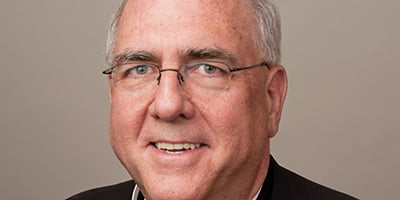by Archbishop Joseph F. Naumann
A few weeks ago, I had the opportunity to spend the better portion of the week with the priests of the archdiocese at our annual convocation at Conception Abbey.
It is always a joy for me to spend time with our priests. They are examples to me of zeal and dedication in the service of God and his people. It is also obvious that they enjoy each other’s company, making it even more of a pleasure to be with them.
The subject of this year’s convocation was the new English translation of the revised Roman Missal that will be introduced throughout the English- speaking world in a little more than a year on the First Sunday of Advent in 2011. This new translation has been in the making for more than a decade.
Compared to the introduction of the Novus Ordo (the New Order, which we use now) for Latin Rite Catholics which introduced Mass in the vernacular (the native languages), this revision and new transla- tion are very minor. Yet, because the Mass and the church’s entire liturgy is so important, even small changes are significant.
We were fortunate to have two excellent presenters: Father Doug Martis, the director of the Liturgical Institute at Mundelein Seminary in Chicago, and Msgr. James Moroney, who headed the Office of Worship at the U. S. Conference of Catholic Bishops for many years and was intimately involved with the development of the new English translation. They helped our priests understand the reasons for the new English translation, the process involved in its development, and the opportunity these changes offer to us to deepen our own understanding and appreciation for the Eucharist.
The first question on everyone’s mind is: Why do we need a new English translation? What’s wrong with the one we have been using for 40 years? Answering the second question first, the current text that we are using for Mass has served us well for many years. It is a good translation of the Latin, but it was done in a relatively short time frame (three years) and at a time when the principles for translation had a different emphasis than the ones that the late Pope John Paul II and Pope Benedict XVI have requested to be used for this revision. The original English translation has served the church extremely well, as evidenced by the remarkable success of introducing the vernacular language for the liturgy in the United States and the English-speaking world.
At the same time, the current English text was always understood to be provisional. Forty years for most of us seems like a very long time. However, in the life of the church, it is a very brief period. The principles for the new English translation have placed a greater emphasis on fidelity to the original (Latin) text, greater doctrinal precision, and more care for the beauty of the manner of expression.
Generally, most of us resist change, especially for something as important as the common expression of our prayer. Yet, what the convocation helped our priests appreciate is that the new English translation provides us all with an opportunity to reflect more carefully upon the meaning and the power of the words of the Mass. The new translation gives us the oppor- tunity to deepen our appreciation for the beauty of the mystery of God’s love that we touch at each Eucharist.
Most of the prayers that we pray at Mass are more than 1,000 years old; some of them, almost 2,000. They connect us with our ancestors in the Catholic faith, who voiced these same prayers more than a millennium ago. While the prayers are ancient, the realities they express are timeless.
Many of the priests told me that the convocation was more like a retreat than a workshop, because it inspired them to reflect not only about the miracle of the Eucharist but about the beauty of their own priestly charism.
Msgr. Moroney identified the temptation for priests to diminish our role as the presider at the Mass by adopting more secular models, such as viewing ourselves as a conductor — whose responsibility is to direct all the other participants; or as an entertainer — striving to engage people by our humor or creativity; or as a politician — attempting to convince the congregation of a particular position. While on any given Sunday, the priest may actually do some things that are consistent with each of those models, none of them are able to capture the essence of the role of the priest.
The priest is called to offer sacrifice in the person of Jesus. By the manner of the actions we perform and the words we speak, we are called to draw others — not to ourselves, but to Jesus. We are the human instruments God uses to make the mystery of his love present to his people. This is indeed an awesome responsibility and privilege.
During the coming year, there will be articles in The Leaven, inserts in parish bulletins, workshops offered in parishes and regions, as well as other catechetical efforts to prepare all of us to welcome the new English translation. However, it is my desire that this year will be a time, not just to get ready to modify the words that we speak at Mass, but an opportunity for each of us to grow in awareness and awe for the miracle of grace in which we participate at each and every Eucharist.


